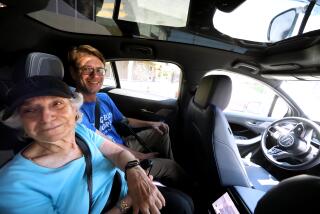Opinion: Will robots push my kids into the unemployment line?
Sometimes I wonder if I’m in the very last generation of newspaper reporters.
After hearing Jeremy Howard talk at a Milken Global Conference panel on robotics this week, however, I’m wondering if I’m in the very last generation of workers.
Howard is chief executive of Enlitic, which uses computers to help doctors make diagnoses. His technology relies on something known as machine learning, or the process by which a computer improves its own capabilities. He’s also a top data scientist, which gives him a much better view of what’s coming than most people have.
This year, Howard said, machines are better than humans at recognizing objects in an image. Now here’s the scary part. Compared to where they were in November, Howard said, they are 15 times faster in recognizing objects while being more accurate and using fewer computational resources. In five years, they will be 10,000 times faster.
“We are seeing order-of-magnitude improvements every few months,” Howard said. Similar leaps are starting to appear in computers’ ability to understand written text.
In five years’ time, a single computer could be hundreds or thousands of times better at that task than humans, Howard said. Combine it with other computers on a network, and the advantage becomes even more pronounced.
“Probably in your lifetime, certainly in your kids’ lifetime ... computers will be better than humans at all these things,” he said. And within five years after that, they will be 1,000 times better.
Gulp.
The math here is based on current trends, of course, so it’s not immutable. Yet in Howard’s view, machine learning is “the first truly exponential technology” in terms of its potential for growth that never plateaus. “Machine learning is about creating better intellectual capacity that can be used to create better intellectual capacity,” he said. In other words, the technology involved in making machines smarter will get smarter too.
But wait, you argue, won’t there always be a demand for human interaction? Personality? Performance? Love? All those emotional and intangible things that make us human?
Howard insists that there’s no reason machines can’t master those tasks too. Think of the movie “Her” as a prediction, not fiction. “How could it not happen?” Howard asked. “What’s the constraint?”
Backing him up on this point were his fellow panelists Amy Webb, a futurist who advises companies on digital strategy, and Gerald Huff, principal software engineer at Tesla Motors. Webb pointed to a new app called Crystal that analyzes a mountain of data about people to help users write emails that are more in tune with the recipient’s personality. Huff noted the work in Japan on “cuddly things that demonstrate the signs of human empathy” that can help care for the elderly.
Here’s a more sobering point.
According to Huff, the federal government recognizes 535 major occupational categories. Only 20% emerged during the past 100 years, and those fields employ only 10% of the workers.
“We added four times more jobs in food services and retail than in every other high-tech industry in the last 20 years,” Huff said. “Those are the jobs we are creating. Those are the jobs that are very subject to automation.”
Of the roughly 145 million U.S. jobs in 2013, some 8% were in science, technology, engineering and math, Huff said. Every creative-industry job in the economy amounted to about 1% of the total.
“We haven’t really had an economy that’s created fundamentally new jobs,” Huff said. Instead, we’ve “shifted work into jobs that robots haven’t been able to do.”
And thanks to machine learning, the list of jobs that robots can’t do is shrinking.
It’s easy to imagine entire categories of work that will be eliminated. For example, Huff said, there are 4 million people in the United States who drive vehicles for a living. Their labor will no longer be valued by the economy in the not-too-distant future of self-driving vehicles. Webb rattled off several similarly doomed professions, from banking and communications to customer service and marketing.
Sounding a less dour note, economist J. Bradford DeLong of UC Berkeley observed that humans have coped successfully for centuries with technology-driven changes. Four thousand years ago, DeLong said, about a third of all labor was devoted to moving heavy things, a job made obsolete when humans domesticated the horse. Yet the substitution of horsepower for personal muscle also ramped up human productivity — a pattern repeated in the centuries of technological advances that followed.
Webb was not so sanguine about the productivity gains to come, asserting that the algorithms that wipe out hundreds of jobs may create work for only a few people to babysit the software. “I might argue that white collar or blue collar of the future is not in fact a collar, but a hoodie,” she said.
To Webb, Huff and Howard, the key will be managing the transition between now and the time when there’s nothing we meager humans can do as well as our robot overlords. Howard put it this way: As machines become better than humans at a growing percentage of the jobs available, there will be a shrinking amount of labor for humans to do that will have any value.
That’s not necessarily a bad thing, mind you. Assuming we can agree on a way to spread the fruit of the robots’ labor to everyone they displaced, the End of Work could usher in a Utopian future. So long, third shift on the assembly line. Hello, Barcalounger.
“Most of the world is doing really awful jobs,” Howard said, although he used a cruder phrase than “really awful.” “More like chopping celery than being a thought leader at the Milken conference.”
He added, “Meaning in life does not come from chopping celery.”
Follow Healey’s intermittent Twitter feed: @jcahealey
More to Read
A cure for the common opinion
Get thought-provoking perspectives with our weekly newsletter.
You may occasionally receive promotional content from the Los Angeles Times.











